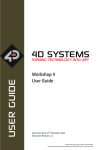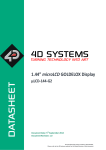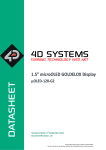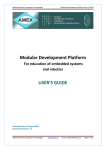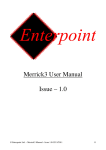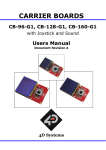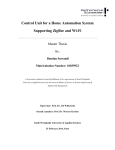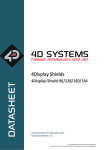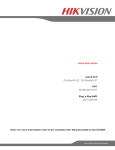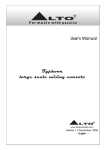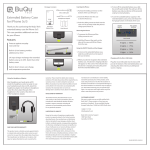Download 4.3” microLCD PICASO Display
Transcript
4D SYSTEMS TURNING TECHNOLOGY INTO ART DATASHEET 4.3” microLCD PICASO Display µLCD-43P/PT/PCT P – Display Only Version PT – Resistive Touch Version PCT – Capacitive Touch Version Document Date: 5th September 2012 Document Revision: 1.0 Uncontrolled Copy when printed or downloaded. Please refer to the 4D Systems website for the latest Revision of this document microLCD PICASO DISPLAY Overview The µLCD-43 is an impressive yet cost effective Intelligent Display Module packed with features, ready to become the GUI for your target application, and capable of being a stand-alone interface controller. Embedded at the heart of the design is the PICASO processor, which is driven by a highly optimised virtual core engine called EVE (Extensible Virtual Engine). An extensive range of hardware and software peripherals have been integrated into the design, to give the user freedom to adapt the module to suit almost any application. The display module is an elegant combination of a 4.3” 480x272 pixel 65K True colour LCD Screen, audio amplifier and speaker, micro-SD card connector, along with a group of general purpose input/output pins (GPIO's), including I2C and serial UART communications. This display module serves as a perfect solution to be deployed at the forefront of any product design, requiring a brilliance of colour, animation, video or images on any application. This PICASO driven Intelligent Display Module is a perfect example of where art meets technology. Audio support provided on the display module is supplied by the PICASO processor, an on-board audio amplifier and 8Ω speaker. A simple instruction enables the user to play audio files while continuing the execution of the user application code, such as display updates, touch recognition, communications and much more. The micro-SD card slot provides the user with expandable memory space suitable for multimedia file retrieval, including images, animations and movie clips, as well as data logging applications. The module can be programmed in its native 4DGL language (similar to C), using the Workshop4 IDE software tool suite, or it can be configured as a serial slave device to use with your favourite host controller. Freedom is at your fingertips with the intelligent µLCD-43 display module. microLCD PICASO DISPLAY Contents 1. Description...................................................................................................................................4 2. Features .......................................................................................................................................4 3. Pin Configuration and Summary ..................................................................................................5 4. Hardware Interface - Pins.............................................................................................................7 4.1. Serial Ports - COM0, COM1 UARTS ........................................................................................................ 7 4.2. General Purpose I/O............................................................................................................................... 7 4.3. System Pins ............................................................................................................................................ 8 5. PmmC/Firmware Programming ...................................................................................................9 6. Module Features ........................................................................................................................10 6.1. Display – 4.3” TFT Touch Screen .......................................................................................................... 10 6.2. PICASO Processor ................................................................................................................................. 10 6.3. Audio .................................................................................................................................................... 10 6.4. SD/SDHC Memory Cards ...................................................................................................................... 10 6.5. FAT16 ................................................................................................................................................... 10 7. Display Precautions....................................................................................................................11 8. Hardware Tools..........................................................................................................................12 8.1. 4D Programming Cable ........................................................................................................................ 12 9. 4DGL - Software Language .........................................................................................................12 10. 4D Systems - Workshop 4 IDE ..................................................................................................13 10.1. Workshop 4 – Designer Environment ................................................................................................ 13 10.2. Workshop 4 – ViSi Environment......................................................................................................... 13 10.3. Workshop 4 – ViSi Genie Environment .............................................................................................. 14 10.4. Workshop 4 – Serial Environment...................................................................................................... 14 11. Mechanical Details ...................................................................................................................15 12. Schematic Diagram – SHEET 1 ..................................................................................................16 13. Schematic Diagram – SHEET 2 ..................................................................................................17 14. Schematic Diagram – SHEET 3 ..................................................................................................18 15. Specifications and Ratings........................................................................................................19 16. Legal Notice..............................................................................................................................21 17. Contact Information .................................................................................................................21 microLCD PICASO DISPLAY 4D SYSTEMS µLCD-43 1. Description 2. Features The µLCD-43 module demonstrates class and finesse in the microLCD range, featuring a 4.3” 480x272 screen resolution that is the ideal size for displaying detailed graphics for many interactive touch applications. • Low-cost 4.3” LCD-TFT display graphics user interface solution. Driving the display and peripherals is the PICASO processor, a very capable and powerful chip which enables stand-alone functionality, programmed using the 4D Systems Workshop 4 IDE Software. The Workshop IDE enables graphic solutions to be constructed rapidly and with ease due to its design being solely for 4D’s graphics processors. The module has an array of features including PWM for Sound, Touch Detection, micro-SD memory storage, general purpose I/O, serial UART communications, an I2C interface and multiple timers, amongst many more features. • 480 x 272 VGA resolution, RGB 65K true to life colours, TFT screen with integrated 4-Wire Resistive Touch Panel (PT Version only) or Capacitive Touch Panel (PCT Version only). • Easy 5 pin interface to any host device: VCC, TX, RX, GND, RESET • Powered by the 4D-Labs PICASO processor (also available as separate OEM IC) • 14KB of flash memory for user code storage and 14KB of SRAM for user variables, or 14KB shared user code and program variables. • 2 x Asynchronous hardware serial UART ports (COM0, COM1), TTL interface, with 300 to 600K baud. 2 • 1 x I C interface (Master). • 8 x 16 bit timers with 1 millisecond resolution. • 13 x General Purpose I/O pins. Supports fast 8bit parallel data transfer through Upper 8 bits. • On-board micro-SD memory card adaptor for multimedia storage and data logging purposes. HC memory card support is also available for cards larger than 4GB. • DOS compatible file access (FAT16 format) as well as low level access to card memory. • Dedicated PWM Audio pin driven by WAV files from micro-SD card. • On-board audio amplifier with a tiny 8Ω speaker for sound generation and WAV file playback. • Built in extensive 4DGL graphics and system library functions. • Display full colour images, animations, icons and video clips. • Supports all available Windows fonts. • A 30 pin header for I/O expansion and future plug-in daughter boards. • 4.5V to 5.5V range operation (single supply). • Module dimensions: 120.0 x 67.3 x 15.2mm (including headers). • Weight ~ 79g. • Display Viewing Area: 94.04 x 53.86mm. • 4 x 3.0mm PCB holes for mechanical mounting. • RoHS Compliant. © 2012 4D SYSTEMS Page 4 of 21 www.4dsystems.com.au µLCD-43 N/C (2) SCL (4) SDA (6) N/C (8) N/C (10) VCC (12) N/C (14) RES (16) N/C (18) 3.3V (20) N/C (22) RX0 (24) TX0 (26) TX1 (28) RX1 (30) 3. Pin Configuration and Summary J1 IO1 (1) IO2 (3) IO3 (5) IO4 (7) IO5 (9) GND (11) GND (13) BUS7 (15) BUS6 (17) BUS5 (19) BUS4 (21) BUS3 (23) BUS2 (25) BUS1 (27) BUS0 (29) microLCD PICASO DISPLAY 4D SYSTEMS Pin Symbol I/O 3, 4 TX O 5, 6 RX I 7, 8 9, 10 GND RES P I 1, 2 +5V P RES (10) GND (8) RX (6) TX (4) +5V (2) RES (9) GND (7) RX (5) TX (3) +5V (1) J2 J2 Pin Outs (Programming Header) Description Main Voltage Supply +ve input pin. Reverse polarity protected. Range is 4.5V to 5.5V, nominal 5.0V. Asynchronous Serial Transmit pin, TTL level. Connect this pin to the Receive (Rx) signal of other serial devices. Used in conjunction with the RX pin for programming this microLCD. This pin is tolerant up to 5.0V levels. Asynchronous Serial Receive pin, TTL level. Connect this pin to the Transmit (Tx) signal of other serial devices. Used in conjunction with the TX pin for programming this microLCD. This pin is tolerant up to 5.0V levels. Supply Ground Master Reset signal. Internally pulled up to 3.3V via a 10K resistor. An active Low pulse greater than 2 micro-seconds will reset the module. If the module needs to be reset externally, only use open collector type circuits. This pin is not driven low by any internal conditions. The host should control this pin via one of its port pins using an open collector/drain arrangement. I = Input, O = Output, P = Power © 2012 4D SYSTEMS Page 5 of 21 www.4dsystems.com.au microLCD PICASO DISPLAY 4D SYSTEMS Pin µLCD-43 1 2 3 4 5 6 7 8 9 10 11 12 13 14 15 16 17 18 19 20 Symbol IO1 N/C IO2 SCL IO3 SDA IO4/BUS_RD N/C IO5/BUS_WR N/C GND +5V GND N/C BUS7 RES BUS6 N/C BUS5 3.3V I/O 21 22 23 24 BUS4 N/C BUS3 RX0 I/O I/O I 25 26 BUS2 TX0 I/O O 27 28 29 30 BUS1 TX1 BUS0 RX1 I/O O I/O I I/O I/O O I/O I/O I/O I/O P P P I/O I I/O I/O I J1 Pin Outs (I/O Expansion Header) Description General Purpose Input Output 1 Pin Not Connected General Purpose Input Output 2 Pin I2C Clock Output General Purpose Input Output 3 Pin I2C Bidirectional Data General Purpose Input Output 4 Pin / Bus Read Not Connected General Purpose Input Output 5 Pin / Bus Write Not connected Supply Ground Supply Input +ve, 4.0V to 5.5V, 5.0V Nominal Supply Ground Not connected IO Bus (BUS0..7) bit 7 Master Reset, Active Low (GND) (Refer J2 Pinout) IO Bus (BUS0..7) bit 6 Not connected IO Bus (BUS0..7) bit 5 Regulated 3.3 Volts output, maximum available current 400mA to power external circuitry. IO Bus (BUS0..7) bit 4 Not connected IO Bus (BUS0..7) bit 3 Asynchronous serial port 0 receive pin. COM0 (same as the RX pin on the J2 Programming Header) IO Bus (BUS0..7) bit 2 Asynchronous serial port 0 transmit pin. COM0 (same as the TX pin on the J2 Programming Header) IO Bus (BUS0..7) bit 1 Asynchronous serial port 1 transmit pin. COM1 IO Bus (BUS0..7) bit 0 Asynchronous serial port 1 receive pin. COM1 I = Input, O = Output, P = Power © 2012 4D SYSTEMS Page 6 of 21 www.4dsystems.com.au microLCD PICASO DISPLAY 4D SYSTEMS µLCD-43 4. Hardware Interface - Pins The µLCD-43 provides both a hardware and software interface. This section describes in detail the hardware interface pins of the device. 4.1. Serial Ports - COM0, COM1 UARTS The µLCD-43 has two dedicated hardware Asynchronous Serial ports that can communicate with external serial devices. These are referred to as the COM0 and the COM1 serial ports. The primary features are: • Full-Duplex 8 bit data transmission and reception. • Data format: 8 bits, No Parity, 1 Stop bit. • Independent Baud rates from 300 baud up to 600K baud. • Single byte transmits and receives or a fully buffered service. The buffered service feature runs in the background capturing and buffering serial data without the user application having to constantly poll any of the serial ports. This frees up the application to service other tasks. A single byte serial transmission consists of the start bit, 8-bits of data followed by the stop bit. The start bit is always 0, while a stop bit is always 1. The LSB (Least Significant Bit, Bit 0) is sent out first following the start bit. Figure below shows a single byte transmission timing diagram. TX0 pin (Serial Transmit COM0): Asynchronous Serial port COM0 transmit pin, TX0. Connect this pin to external serial device receive (Rx) signal. This pin is 5.0V tolerant. RX0 pin (Serial Receive COM0): Asynchronous Serial port COM0 receive pin, RX0. Connect this pin to external serial device transmit (Tx) signal. This pin is 5.0V tolerant. TX1 pin (Serial Transmit COM1): Asynchronous Serial port COM1 transmit pin, TX1. Connect this pin to external serial device receive (Rx) signal. This pin is 5.0V tolerant. RX1 pin (Serial Receive COM1): Asynchronous Serial port COM1 receive pin, RX1. Connect this pin to external serial device transmit (Tx) signal. This pin is 5.0V tolerant. 4.2. General Purpose I/O There are 13 general purpose Input/Output (GPIO) pins available to the user. These are grouped as IO1..IO5 and BUS0..BUS7. Power-Up Reset default is all INPUTS. The 5 I/O pins (IO1..IO5), provide flexibility of individual bit operations while the 8 pins (BUS0..BUS7), known as GPIO BUS, serve collectively for byte wise operations. The IO4 and IO5 also act as strobing signals to control the GPIO Bus. GPIO Bus can be read or written by strobing a low pulse (50ns duration or greater) the IO4/BUS_RD or IO5/BUS_WR for read or write respectively. For detailed usage refer to the document: “PICASO-4DGL-Internal-Functions.pdf” IO1-IO3 pins (3 x GPIO pins): General purpose I/O pins. Each pin can be individually set for INPUT or an OUTPUT. IO4/BUS_RD pin (GPIO IO4 or BUS_RD pin): General Purpose IO4 pin. Also used for BUS_RD signal to read and latch the data in to the parallel GPIO BUS0..BUS7. COM0 is also the primary interface for 4DGL user program downloads and chip configuration (PmmC programming). Once the compiled 4DGL application program (EVE byte-code) is downloaded and the user code starts executing, the serial port is then available to the user application. Refer to Section 5. ‘Firmware / PmmC Programming’ for more details on this subject. © 2012 4D SYSTEMS IO5/BUS_WR pin (GPIO IO5 or BUS_WR pin): General Purpose IO5 pin. Also used for BUS_WR signal to write and latch the data to the parallel GPIO BUS0..BUS7. BUS0-BUS7 pins (GPIO 8-Bit Bus): 8-bit parallel General purpose I/O Bus. Note: All GPIO pins are 5.0V tolerant. Page 7 of 21 www.4dsystems.com.au 4D SYSTEMS µLCD-43 4.3. System Pins +5V (Module Voltage Input) J1 pin 12, J2 pins 1/2: Module supply voltage input pin. This pin must be connected to a regulated supply voltage in the range of 4.5 Volts to 5.5 Volts DC. Nominal operating voltage is 5.0 Volts. RESET (Module Master Reset) J1 pin 16, J2 pins 9/10: Module Master Reset pin. An active low pulse of greater than 2μs will reset the module. Internally pulled up to 3.3V via a 10K resistor. Only use open collector type circuits to reset the device if an external reset is required. microLCD PICASO DISPLAY 3.3V Out (3.3V Regulated Output) J1 pin 20: External circuitry that requires a regulated 3.3V supply can be powered up via this pin. Maximum available current is 400mA. GND (Module Ground) J1 pins 11/13, J2 pins 7/8: Device ground pins. These pins must be connected to ground. © 2012 4D SYSTEMS Page 8 of 21 www.4dsystems.com.au microLCD PICASO DISPLAY 4D SYSTEMS µLCD-43 5. PmmC/Firmware Programming The PICASO processor used in the µLCD-43 module is a custom graphics processor. All functionality including the high level commands are built into the chip. This chip level configuration is available as a Firmware/PmmC (Personality-module-microCode) file. A PmmC file contains all of the low level microcode information (analogy of that of a soft silicon) which define the characteristics and functionality of the device. The ability of programming the device with a PmmC file provides an extremely flexible method of customising as well as upgrading it with future enhancements. A PmmC file can only be programmed into the device via its COM0 serial port. Figure below provides a typical implementation for the PmmC programming interface. The PmmC file is programmed into the device with the aid of Workshop 4, the 4D Systems IDE software (See Section 11). To provide a link between the PC and the ICSP interface, a specific 4D Programming Cable is required and is available from 4D Systems. Using a non-4D programming interface could damage your display, and void your Warranty. 4D Programming Cable © 2012 4D SYSTEMS Page 9 of 21 www.4dsystems.com.au microLCD PICASO DISPLAY 4D SYSTEMS µLCD-43 6. Module Features The µLCD-43 module is designed to accommodate most applications. Some of the main features of the module are listed below. Powerful graphics, text, image, animation and countless more features are built right inside the chip. The data sheet for the processor is available from the http://www.4dsystems.com.au website: “PICASO-DS-revx.pdf” 6.1. Display – 4.3” TFT Touch Screen The µLCD-43 module is equipped with a 4.3” TFT display. Details of the display are listed below: • Screen Size: 4.3” diagonal, 480x272 resolution, 65K colours • Integrated 4-Wire Resistive Touch Screen (PT) • Integrated Capacitive Touch Screen (PCT) • Screen Dimensions: 105.4 x 67.1 x 2.9mm • Viewing Area: 95.04 x 53.86mm • Pixel Pitch: 0.153 x 0.153mm • Brightness: 250cd/m2 • Contrast Ratio: 300:1 • Viewing Angle Above Centre: 50 degrees • Viewing Angle Below Centre: 20 degrees • Viewing Angle Left of Centre: 45 degrees • Viewing Angle Right of Centre: 45 degrees • Viewing Direction: 12 O'clock • 5x2 Parallel LEDs for Backlighting 6.3. Audio Audio playback support in the PICASO Processor enables the µLCD-43 module to play audio WAV files stored in the micro-SD memory card. PWM and an on-board audio amplifier with 8Ω speaker ensure ample audio output capability. A simple instruction enables the user to play/pause/stop audio files while continuing the execution of the user application code, such as display updates, touch recognition, communications, etc. The audio system also allows real time pitch change of audio samples. For a complete list of audio commands please refer to the separate document titled: “PICASO-4DGL-Internal-Functions.pdf” Note: The Displays used are the highest rated ‘Grade A’ Displays, which allow for 0-4 defective pixels. A defective pixel could be solid Black (Dead), White, Red, Green or Blue. Note: The on-board speaker is a small device designed to project into an audio cavity. It is not very loud by itself. To enable louder audio, it is recommended to use a larger external 8Ω speaker. See the ‘Hardware Interface Pins’ – ‘System Pins’ section for more information. 6.2. PICASO Processor 6.4. SD/SDHC Memory Cards The module is designed around the PICASO Graphics Processor from 4D-Labs. The module supports micro-SD memory cards via the on-board micro-SD connector. The memory card is used for all multimedia file retrieval such as images, animations and movie clips. The memory card can also be used as general purpose storage for data logging applications. Support is available for off the shelf micro-SD and high capacity HC memory cards (4GB and above). The PICASO GPU is a smart Controller and the interface to the TFT- LCD displays is almost plug-nplay. All of the data and control signals are provided by the chip to interface directly to the display. © 2012 4D SYSTEMS 6.5. FAT16 The µLCD-43 uses off the shelf standard SDHC/SD/micro-SD memory cards with up to 2GB capacity usable with FAT16 formatting. For any FAT file related operations, before the memory Page 10 of 21 www.4dsystems.com.au microLCD PICASO DISPLAY 4D SYSTEMS µLCD-43 card can be used it must first be formatted with FAT16 option. The formatting of the card can be done on any PC system with a card reader. Select the appropriate drive and choose the FAT16 (or just FAT in some systems) option when formatting. The card is now ready to be used in the PICASO based application. The µLCD-43 also supports high capacity HC memory cards (4GB and above). The available capacity of SD-HC cards varies according to the way the card is partitioned and the commands used to access it. The FAT partition is always first (if it exists) and can be up to the maximum size permitted by FAT16. Windows 7 will format FAT16 up to 4GB. Windows XP will format FAT16 up to 2GB and the Windows XP command prompt will format FAT16 up to 4GB. 7. Display Precautions • Avoid having to display the same image/object on the screen for lengthy periods of time. This will cause a burn-in which is a common problem with all types of display technologies. Blank the screen after a while or dim it very low by adjusting the contrast. Better still; implement a screen saver feature. • Moisture and water can damage the display. Moisture on the surface of a powered display will cause the electrodes to corrode. Wipe off any moisture gently or let the display dry before usage. • Dirt from fingerprint oil and fat can easily stain the surface of the display. Gently wipe off any stains with a soft lint-free cloth. • The performance of the display will degrade under high temperature and humidity. Avoid such conditions when storing. • Do not tamper with the display flex cable that is connected to the control board. This may affect the connection between the display and the driving circuitry and cause failure. • Displays are susceptible to mechanical shock and any force exerted on the module may result in deformed zebra stripes, a cracked display cell and broken backlight • Always use the mounting holes on the module's corner plates to mount the display. © 2012 4D SYSTEMS Page 11 of 21 www.4dsystems.com.au microLCD PICASO DISPLAY 4D SYSTEMS µLCD-43 8. Hardware Tools 9. 4DGL - Software Language The following hardware tools are required for full control of the µLCD-43 module. The µLCD-43 utilises the PICASO processor, which belongs to a family of processors powered by a highly optimised soft core virtual engine, EVE (Extensible Virtual Engine). 8.1. 4D Programming Cable The 4D Programming Cable is an essential hardware tool to program, customise and test the µLCD-43 module. The 4D Programming Cable is used to program a new Firmware/PmmC and downloading compiled 4DGL code into the module. It even serves as an interface for communicating serial data to the PC. The 4D Programming Cable is available from 4D Systems, www.4dsystems.com.au EVE is a proprietary, high performance virtualmachine with an extensive byte-code instruction set optimised to execute compiled 4DGL programs. 4DGL (4D Graphics Language) was specifically developed from ground up for the EVE engine core. It is a high level language which is easy to learn and simple to understand yet powerful enough to tackle many embedded graphics applications. 4DGL is a graphics oriented language allowing rapid application development, and the syntax structure was designed using elements of popular languages such as C, Basic, Pascal and others. Programmers familiar with these languages will feel right at home with 4DGL. It includes many familiar instructions such as IF..ELSE..ENDIF, WHILE..WEND, REPEAT..UNTIL, GOSUB..ENDSUB, GOTO, PRINT as well as some specialised instructions SERIN, SEROUT, GFX_LINE, GFX_CIRCLE and many more. For detailed information pertaining to the 4DGL language, please refer to the following documents: “4DGL-Programmers-Reference-Manual.pdf” “PICASO-4DGL-Internal-Functions.pdf” To assist with the development of 4DGL applications, the Workshop 4 IDE combines a fullfeatured editor, a compiler, a linker and a downloader into a single PC-based application. It's all you need to code, test and run your applications. 4DGL is available to be written in two of the four environments offered by the Workshop 4 IDE, Designer and ViSi. © 2012 4D SYSTEMS Page 12 of 21 www.4dsystems.com.au microLCD PICASO DISPLAY 4D SYSTEMS µLCD-43 10. 4D Systems - Workshop 4 IDE 10.1. Workshop 4 – Designer Environment Workshop 4 is a comprehensive software IDE that provides an integrated software development platform for all of the 4D family of processors and modules. The IDE combines the Editor, Compiler, Linker and Down- Loader to develop complete 4DGL application code. All user application code is developed within the Workshop 4 IDE. Choose the Designer environment to write 4DGL code in its raw form. The Designer environment provides the user with a simple yet effective programming environment where pure 4DGL code can be written, compiled and downloaded to the µLCD-43. The Workshop 4 IDE supports multiple development environments for the user, to cater for different user requirements and skill level. • • • • The Designer environment enables the user to write 4DGL code in its natural form to program the µLCD-43. A visual programming experience, suitably called ViSi, enables drag-and-drop type placement of objects to assist with 4DGL code generation and allows the user to visualise how the display will look while being developed. An advanced environment called ViSi-Genie doesn’t require any 4DGL coding at all, it is all done automatically for you. Simply lay the display out with the objects you want, set the events to drive them and the code is written for you automatically. ViSi-Genie provides the latest rapid development experience from 4D Systems. A Serial environment is also provided to transform the µLCD-43 into a slave serial module, allowing the user to control the display from any host microcontroller or device with a serial port. The Workshop 4 IDE is available from the 4D Systems website. www.4dsystems.com.au 10.2. Workshop 4 – ViSi Environment ViSi was designed to make the creation of graphical displays a more visual experience. ViSi is a great software tool that allows the user to see the instant results of their desired graphical layout. Additionally, there is a selection of inbuilt dials, gauges and meters that can simply be placed onto the simulated module display. From here each object can have its properties edited, and at the click of a button all relevant 4DGL code associated with that object is produced in the user program. The user can then write 4DGL code around these objects to utilise them in the way they choose. For a comprehensive manual on the Workshop 4 IDE Software, refer to its documentation from the 4D Systems website. “Workshop-4-IDE-User-Manual.pdf” © 2012 4D SYSTEMS Page 13 of 21 www.4dsystems.com.au microLCD PICASO DISPLAY 4D SYSTEMS µLCD-43 10.3. Workshop 4 – ViSi Genie Environment 10.4. Workshop 4 – Serial Environment ViSi Genie is a breakthrough in the way 4D Systems’ graphic display modules are programmed. It is an environment like no other, a code-less programming environment that provides the user with a rapid visual experience, enabling a simple GUI application to be ‘written’ from scratch in literally seconds. The Serial environment in the Workshop 4 IDE provides the user the ability to transform the µLCD-43 into a slave serial graphics controller. ViSi Genie does all the background coding, no 4DGL to learn, it does it all for you. Pick and choose the relevant objects to place on the display, much like the ViSi Environment (See Section 11.2), yet without having to write a single line of code. Each object has parameters which can be set, and configurable events to animate and drive other objects or communicate with external devices. Simply place an object on the screen, position and size it to suit, set the parameters such as colour, range, text, and finally select the event you wish the object to be associated with, it is that simple. This enables the user to use their favourite microcontroller or serial device as the Host, without having to learn 4DGL or program in a separate IDE. Once the µLCD-43 is configured and downloaded to from the Serial Environment, simple graphic commands can be sent from the users host microcontroller to display primitives, images, sound or even video. Refer to the Serial Environment section in the Workshop 4 user manual, for a complete listing of all the supported serial commands “Workshop-4-IDE-User-Manual.pdf” By default, each module shipped from the 4D Systems factory will come pre-programmed ready for use in the Serial mode. In seconds you can transform a blank display into a fully animated GUI with moving sliders, animated press and release buttons, and much more. All without writing a single line of code! ViSi Genie provides the user with a feature rich rapid development environment, second to none. © 2012 4D SYSTEMS Page 14 of 21 www.4dsystems.com.au 4D SYSTEMS µLCD-43 microLCD PICASO DISPLAY 11. Mechanical Details © 2012 4D SYSTEMS Page 15 of 21 www.4dsystems.com.au 4D SYSTEMS µLCD-43 microLCD PICASO DISPLAY 12. Schematic Diagram – SHEET 1 © 2012 4D SYSTEMS Page 16 of 21 www.4dsystems.com.au 4D SYSTEMS µLCD-43 microLCD PICASO DISPLAY 13. Schematic Diagram – SHEET 2 © 2012 4D SYSTEMS Page 17 of 21 www.4dsystems.com.au 4D SYSTEMS µLCD-43 microLCD PICASO DISPLAY 14. Schematic Diagram – SHEET 3 © 2012 4D SYSTEMS Page 18 of 21 www.4dsystems.com.au microLCD PICASO DISPLAY 4D SYSTEMS µLCD-43 15. Specifications and Ratings ABSOLUTE MAXIMUM RATINGS Operating ambient temperature ................................................................................................... -15°C to +65°C Storage temperature .......................................................................................................................... -30°C +70°C Voltage on any digital input pin with respect to GND ....................................................................... -0.3V to 6.0V Voltage on SWITCH pin with respect to GND ................................................................................... -0.3V to 6.0V Voltage on VCC with respect to GND ................................................................................................. -0.3V to 6.0V NOTE: Stresses above those listed here may cause permanent damage to the device. This is a stress rating only and functional operation of the device at those or any other conditions above those indicated in the recommended operation listings of this specification is not implied. Exposure to maximum rating conditions for extended periods may affect device reliability. RECOMMENDED OPERATING CONDITIONS Parameter Supply Voltage (VCC) Operating Temperature Input Low Voltage (VIL) Input High Voltage (VIH) Input High Voltage (VIH) Reset Pulse Operational Delay Conditions VCC = 3.3V, all pins VCC = 3.3V, non 5V tolerant pins All GPIO pins, RX0 and TX0 pins External Open Collector Power-Up or External Reset Min 4.5 -10 VGND 0.8VCC 0.8VCC 2.0 500 Typ 5.0 ------- Max 5.5 +60 0.2VCC VCC 5.5 -3000 Units V °C V V V µs ms GLOBAL CHARACTERISTICS BASED ON OPERATING CONDITIONS Parameter Supply Current (ICC) Output Low Voltage (VOL) Output High Voltage (VOH) Capacitive Loading Flash Memory Endurance Conditions VCC = 5.0V, heavily depends on screen usage conditions, sleep mode Min Typ Max Units 4 150 170 mA VCC = 5.0V, IOL = 3.4mA -- -- 0.4 V VCC = 5.0V, IOL = -2.0mA 2.4 -- -- V All pins -- -- 50 pF PICASO PmmC Programming -- 10000 -- E/W Typ ------- Max <1.5 850 580 ---- Units % Ohm Ohm K Million % TOUCH SCREEN CHARACTERISTICS Parameter Linearity Terminal Resistance X Terminal Resistance Y Durability – Scratch Test Durability – Tap Test Transparency © 2012 4D SYSTEMS Conditions X film side Y film side Stylus Pen or Finger Sliding Stylus Pen or Finger Press Non Glare Page 19 of 21 Min -200 150 100 1 82 www.4dsystems.com.au microLCD PICASO DISPLAY 4D SYSTEMS µLCD-43 OPTICAL CHARACTERISTICS Parameter Contrast ratio (Centre point) Condition Min 250 Typ 300 Max -- Units -- 250 -- -- Cd/m 80 -- -- % -- 30 -- ms 0.25 0.275 0.32 0.25 0.275 0.32 0.25 0.25 0.275 0.275 0.32 0.32 Green, Gx 0.25 0.275 0.32 Green, Gy 0.25 0.275 0.32 Blue, Bx Blue, By Vertical above Centre Vertical below Centre Horizontal Left of Centre Horizontal Right of Centre 0.25 0.25 0.275 0.275 50 20 45 45 0.32 0.32 Luminance of white (Centre point) White Uniformity Response Rising + Falling Time (Tr + Tf) White, Wx White, Wy Colour Chromaticity (CIE 1931) Viewing Angle Back-light On Red, Rx Red, Ry Contrast Ratio > 10 2 Degrees ORDERING INFORMATION Order Code: • µLCD-43P – Non Touch • µLCD-43PT – Resistive Touch (least sensitive, best used with stylus touch) • µLCD-43PCT – Capacitive Touch (most sensitive, best used with finger touch) Package: 138mm x 100mm x 30mm Packaging: Module sealed in antistatic foam padded 4D Systems Box © 2012 4D SYSTEMS Page 20 of 21 www.4dsystems.com.au microLCD PICASO DISPLAY 4D SYSTEMS µLCD-43 16. Legal Notice Proprietary Information The information contained in this document is the property of 4D Systems Pty. Ltd. and may be the subject of patents pending or granted, and must not be copied or disclosed without prior written permission. 4D Systems endeavours to ensure that the information in this document is correct and fairly stated but does not accept liability for any error or omission. The development of 4D Systems products and services is continuous and published information may not be up to date. It is important to check the current position with 4D Systems. 4D Systems reserves the right to modify, update or makes changes to Specifications or written material without prior notice at any time. All trademarks belong to their respective owners and are recognised and acknowledged. Disclaimer of Warranties & Limitation of Liability 4D Systems makes no warranty, either expressed or implied with respect to any product, and specifically disclaims all other warranties, including, without limitation, warranties for merchantability, non-infringement and fitness for any particular purpose. Information contained in this publication regarding device applications and the like is provided only for your convenience and may be superseded by updates. It is your responsibility to ensure that your application meets with your specifications. Images and graphics used throughout this document are for illustrative purposes only. All images and graphics used are possible to be displayed on the 4D Systems range of products, however the quality may vary. In no event shall 4D Systems be liable to the buyer or to any third party for any indirect, incidental, special, consequential, punitive or exemplary damages (including without limitation lost profits, lost savings, or loss of business opportunity) arising out of or relating to any product or service provided or to be provided by 4D Systems, or the use or inability to use the same, even if 4D Systems has been advised of the possibility of such damages. 4D Systems products are not fault tolerant nor designed, manufactured or intended for use or resale as on line control equipment in hazardous environments requiring fail – safe performance, such as in the operation of nuclear facilities, aircraft navigation or communication systems, air traffic control, direct life support machines or weapons systems in which the failure of the product could lead directly to death, personal injury or severe physical or environmental damage (‘High Risk Activities’). 4D Systems and its suppliers specifically disclaim any expressed or implied warranty of fitness for High Risk Activities. Use of 4D Systems’ products and devices in 'High Risk Activities' and in any other application is entirely at the buyer’s risk, and the buyer agrees to defend, indemnify and hold harmless 4D Systems from any and all damages, claims, suits, or expenses resulting from such use. No licenses are conveyed, implicitly or otherwise, under any 4D Systems intellectual property rights. 17. Contact Information For Technical Support: [email protected] For Sales Support: [email protected] Website: www.4dsystems.com.au Copyright 4D Systems Pty. Ltd. 2000-2012. © 2012 4D SYSTEMS Page 21 of 21 www.4dsystems.com.au





















